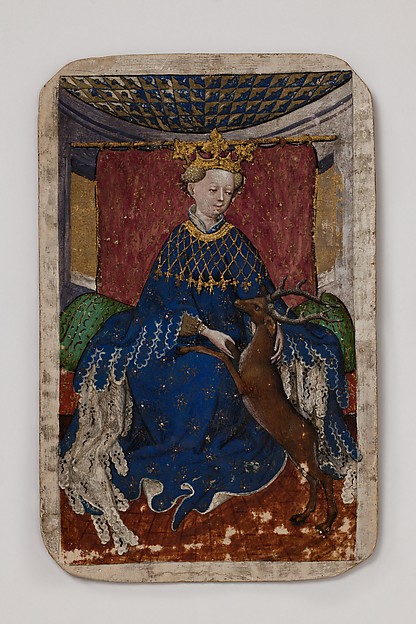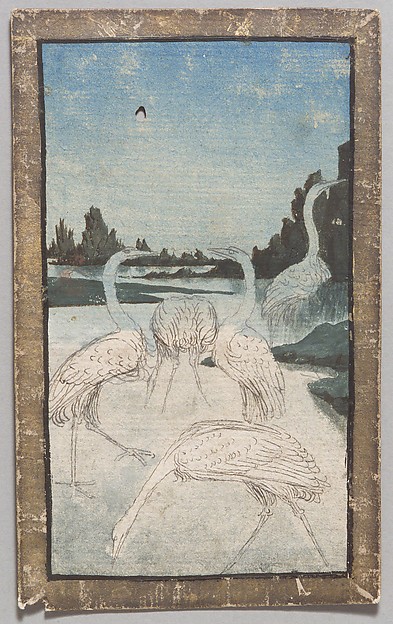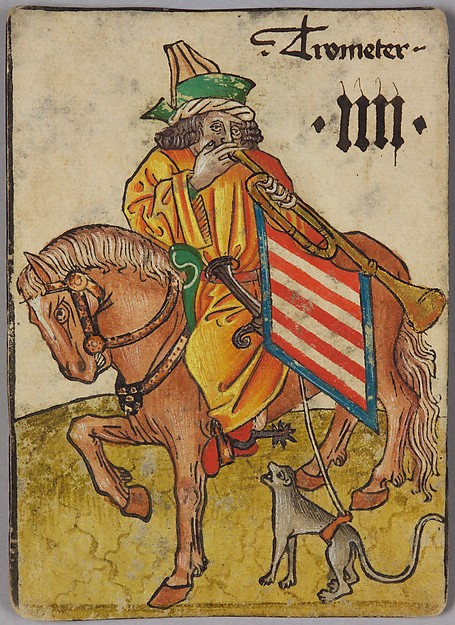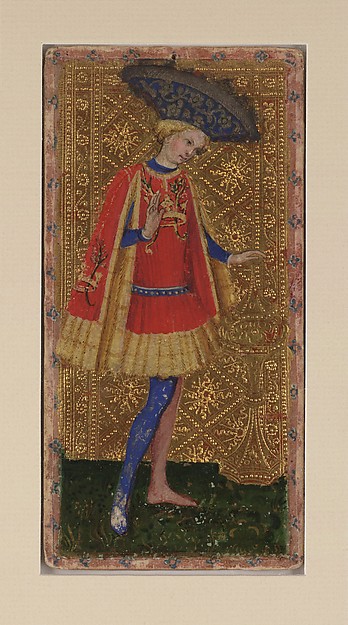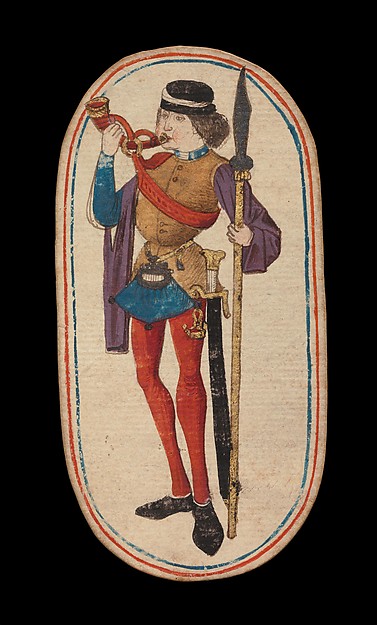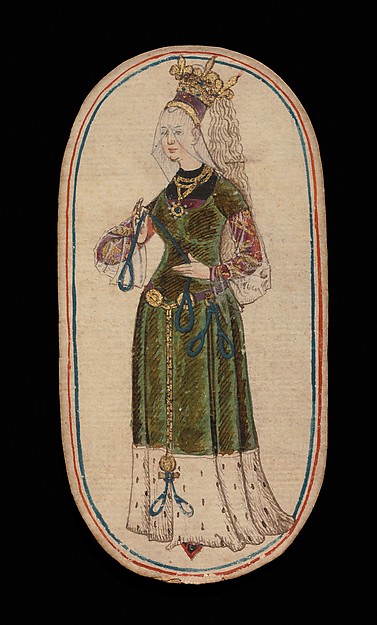The World in Play: Luxury Cards, 1430–1540
The Cloisters, New York City
January 20–April 17, 2016
Only three decks of European hand-painted playing cards are known to have survived from the late Middle Ages—two made in Germany and one in the Burgundian Netherlands, all dating from the early to late 15th century. The only complete set of these luxury cards—The Cloisters Playing Cards, from the southern Netherlands—and representative examples from the other two decks will be featured in the exhibition The World in Play: Luxury Cards, 1430–1540, opening January 20 at The Cloisters.
The earliest surviving deck of hand-painted woodcut cards—and the finest example of such work from the German Renaissance—will also be included in the exhibition, where contextual background will be provided by 15th-century engraved and woodcut playing cards from Germany and tarot cards from North Italy. Among the works on view will be examples by the Basel painter Konrad Witz (1400–1445) and two other artists of the period who were known as Master E. S. and Master of the Playing Cards.
The Cloisters is the branch of the Metropolitan Museum dedicated to the art and architecture of medieval Europe.
Card games originated in China in the ninth century and were later taken up in India and the Middle East. Playing cards first appeared in Europe around the late 14th century, probably through trade. Because card games often involved gambling, clerical and civilian authorities in Europe banned cards. Early European decks were not standardized and featured diverse suit pictures as well as variety in the number of suits and the number of cards.
Exhibition Overview
The three hand-painted decks represented in the exhibition—the Stuttgart Cards (ca. 1430), the Ambras Courtly Hunt Cards (ca. 1440), and The Cloisters Playing Cards (ca. 1470–80)—were made over a span of some 50 years by different artists in different locations. Although each of these decks is unique, all feature images related to hunting, a favorite leisure activity of medieval nobility. The high quality of the paintings and excellent condition of the cards suggest that the luxury sets were never played. Rather, they may have served as engaging collectors’ items, like portfolios of prints or drawings, for the private enjoyment of their owners.
Representing the earliest known deck of cards is the incomplete Stuttgart Cards (12 of the 49 remaining cards in this deck will be on view at The Cloisters). Although the theme is the hunt, no actual hunt is shown. Rather, the imagery of the Stuttgart Cards serves as a metaphor for the patron’s view of the world, evoking a chivalric past in which man exists in harmony with nature. The deck’s four suits are falcons, hounds, ducks, and stags.
On the basis of overall style and the treatment of landscapes, the Ambras Courtly Hunt Cards are attributed to the workshop of the noted German painter Konrad Witz. The suits are lures, falcons, herons, and hounds. Six cards from this deck will be displayed.
The Cloisters Playing Cards are the earliest complete set of cards, and are among the more intriguing works of secular art in the collection of The Cloisters. The exhibition marks the first time that all 52 cards will be displayed at The Cloisters at the same time. (Because works on paper are sensitive to light, normally only a small number of the cards have been shown at one time.) The suits in The Cloisters deck are nooses, collars, leashes, and hunting horns.
Six examples from the 16th-century Courtly Household cards—the earliest deck of printed cards—will provide a fascinating glimpse into the organization of a late medieval princely court. The four suits correspond to the kingdoms of Germany, France, Bohemia, and Hungary. The hand-colored cards in this set are embellished in silver and gold leaf and represent the varied ranks at court: king, queen, marshal, chaplain, physician, chancellor, court mistress, barber, herald, fishmonger, and fool. Some occupations are depicted in all four suits, others appear only once. The deck represents some of the earliest German woodblock prints in existence.
A later set of woodblock printed cards from Nuremburg around 1540, by German sculptor, designer, and printmaker Peter Flötner, is distinguished by the musical notations that appear on the back of each card. The cards from this deck—all of which will be shown in the exhibition—are hand colored, with silver and gold embellishments. The suit pictures—acorns, leaves, hearts, and bells—had by this time become standard in Germany.
Queen of Stags, from The Stuttgart Playing Cards (Das Stuttgarter Kartenspiel) German, Upper Rhineland, ca. 1430
Paper (six layers in pasteboard) with gold ground and opaque paint over pen and ink
7 1⁄2 × 4 3⁄4 in. (19.1 × 12.1 cm)
Landesmuseum Württemberg, Stuttgart (KK grau 15)
Image: © Landesmuseum Württemberg, Stuttgart, photo: H. Zwietasch
Under Knave of Ducks, from The Stuttgart Playing Cards (Das Stuttgarter Kartenspiel)
German, Upper Rhineland, ca. 1430
Paper (six layers in pasteboard) with gold ground and opaque paint over pen and ink 7 1⁄2 × 4 3⁄4 in. (19.1 × 12.1 cm)
Paper (six layers in pasteboard) with gold ground and opaque paint over pen and ink
7 1⁄2 × 4 3⁄4 in. (19.1 × 12.1 cm)
Landesmuseum Württemberg, Stuttgart (KK grau 15)
Image: © Landesmuseum Württemberg, Stuttgart, photo: H. Zwietasch
Under Knave of Ducks, from The Stuttgart Playing Cards (Das Stuttgarter Kartenspiel)
German, Upper Rhineland, ca. 1430
Paper (six layers in pasteboard) with gold ground and opaque paint over pen and ink 7 1⁄2 × 4 3⁄4 in. (19.1 × 12.1 cm)
Landesmuseum Württemberg, Stuttgart (KK grau 42)
Image: © Landesmuseum Württemberg, Stuttgart, photo: H. Zwietasch
9 of Hounds, from The Courtly Hunt Cards (Das Hofjagdspiel) Workshop of Konrad Witz (active in Basel, 1434–44)
German, Upper Rhineland, ca. 1440–45
Paper (pasteboard) with watercolor, opaque paint, and gold over pen and ink 6 1⁄4 × 3 7⁄8 in. (15.9 × 9.8 cm)
Kunsthistorisches Museum Wien, Kunstkammer (KK 5032) Image: © Kunsthistorisches Museum, Vienna
Image: © Landesmuseum Württemberg, Stuttgart, photo: H. Zwietasch
9 of Hounds, from The Courtly Hunt Cards (Das Hofjagdspiel) Workshop of Konrad Witz (active in Basel, 1434–44)
German, Upper Rhineland, ca. 1440–45
Paper (pasteboard) with watercolor, opaque paint, and gold over pen and ink 6 1⁄4 × 3 7⁄8 in. (15.9 × 9.8 cm)
Kunsthistorisches Museum Wien, Kunstkammer (KK 5032) Image: © Kunsthistorisches Museum, Vienna
5 of Herons, from The Courtly Hunt Cards (Das Hofjagdspiel) Workshop of Konrad Witz (active in Basel, 1434–44)
German, Upper Rhineland, ca. 1440–45
Paper (pasteboard) with watercolor, opaque paint, and gold over pen and ink 6 1⁄4 × 3 7⁄8 in. (15.9 × 9.8 cm)
Kunsthistorisches Museum Wien, Kunstkammer (KK 5053) Image: © Kunsthistorisches Museum, Vienna
4 (Trumpeter) of Hungary, from The Courtly Household Cards (Das Hofämterspiel)
German, Upper Rhineland, ca. 1450
Woodcut on paper (pasteboard) with watercolor, opaque paint, pen and ink, and tooled gold and silver
5 1⁄2 × 3 15/16 in. (14 × 10 cm)
Kunsthistorisches Museum Wien, Kunstkammer (KK 5088) Image: © Kunsthistorisches Museum, Vienna
6 (Lady-in-Waiting) of France, from The Courtly Household Cards (Das Hofämterspiel)
German, Upper Rhineland, ca. 1450
Woodcut on paper (pasteboard) with watercolor, opaque paint, pen and ink, and tooled gold and silver
5 1⁄2 × 3 15/16 in. (14 × 10 cm)
Kunsthistorisches Museum Wien, Kunstkammer (KK 5118) Image: © Kunsthistorisches Museum, Vienna
Knave of Cups, from The Visconti Tarot
Workshop of Bonifacio Bembo (Italian, active ca. 1442–77; d. before 1482)
Italian, Milan, ca. 1450
Paper (pasteboard) with opaque paint on tooled gold ground
7 3⁄8 × 3 1⁄2 in. (18.9 × 9 cm)
Beinecke Rare Book & Manuscript Library, Yale University,
New Haven, Connecticut (ITA 109)
Image: © Beinecke Rare Book and Manuscript Library, Yale University, New Haven
World, from The Visconti Tarot
Workshop of Bonifacio Bembo (Italian, active ca. 1442–77; d. before 1482)
Italian, Milan, ca. 1450
Paper (pasteboard) with opaque paint on tooled gold ground
7 3⁄8 × 3 1⁄2 in. (18.9 × 9 cm)
Beinecke Rare Book & Manuscript Library, Yale University,
New Haven, Connecticut (ITA 109)
Image: © Beinecke Rare Book and Manuscript Library, Yale University, New Haven
Knave of Horns, from The Cloisters Playing Cards
South Netherlandish, Burgundian territories, ca. 1475–80
Paper (four layers in pasteboard) with pen and ink, opaque paint, glazes, and applied silver and gold
5 3/16 × 2 3⁄4 in. (13.2 × 7 cm)
The Metropolitan Museum of Art, New York, The Cloisters Collection, 1983 (1983.515.3)
Image: © The Metropolitan Museum of Art, New York
Queen of Nooses, from The Cloisters Playing Cards
South Netherlandish, Burgundian territories, ca. 1475–80
Paper (four layers in pasteboard) with pen and ink, opaque paint, glazes, and applied silver and gold
5 3/16 × 2 3⁄4 in. (13.2 × 7 cm)
The Metropolitan Museum of Art, New York, The Cloisters Collection, 1983 (1983.515.41)
Image: © The Metropolitan Museum of Art, New York
4 of Leafs from The Playing Cards of Peter Flötner and King of Bells, from The Playing Cards of Peter Flötner Peter Flötner (German, Thurgau 1485–1546 Nuremberg) Published by Hans Christoph Zell
German, Nuremberg, ca. 1540
Woodcut on paper with watercolor, opaque paint, and gold 4 1⁄8 × 2 3⁄8 in. (10.5 × 5.9 cm)
Germanisches Nationalmuseum, Nuremberg (GMN Sp 7418 1–47 Kapsel 516) Image: © Germanisches Nationalmuseum, Nuremberg, photo: Monika Runge
German, Upper Rhineland, ca. 1450
Woodcut on paper (pasteboard) with watercolor, opaque paint, pen and ink, and tooled gold and silver
5 1⁄2 × 3 15/16 in. (14 × 10 cm)
Kunsthistorisches Museum Wien, Kunstkammer (KK 5088) Image: © Kunsthistorisches Museum, Vienna
6 (Lady-in-Waiting) of France, from The Courtly Household Cards (Das Hofämterspiel)
German, Upper Rhineland, ca. 1450
Woodcut on paper (pasteboard) with watercolor, opaque paint, pen and ink, and tooled gold and silver
5 1⁄2 × 3 15/16 in. (14 × 10 cm)
Kunsthistorisches Museum Wien, Kunstkammer (KK 5118) Image: © Kunsthistorisches Museum, Vienna
Knave of Cups, from The Visconti Tarot
Workshop of Bonifacio Bembo (Italian, active ca. 1442–77; d. before 1482)
Italian, Milan, ca. 1450
Paper (pasteboard) with opaque paint on tooled gold ground
7 3⁄8 × 3 1⁄2 in. (18.9 × 9 cm)
Beinecke Rare Book & Manuscript Library, Yale University,
New Haven, Connecticut (ITA 109)
Image: © Beinecke Rare Book and Manuscript Library, Yale University, New Haven
World, from The Visconti Tarot
Workshop of Bonifacio Bembo (Italian, active ca. 1442–77; d. before 1482)
Italian, Milan, ca. 1450
Paper (pasteboard) with opaque paint on tooled gold ground
7 3⁄8 × 3 1⁄2 in. (18.9 × 9 cm)
Beinecke Rare Book & Manuscript Library, Yale University,
New Haven, Connecticut (ITA 109)
Image: © Beinecke Rare Book and Manuscript Library, Yale University, New Haven
Knave of Horns, from The Cloisters Playing Cards
South Netherlandish, Burgundian territories, ca. 1475–80
Paper (four layers in pasteboard) with pen and ink, opaque paint, glazes, and applied silver and gold
5 3/16 × 2 3⁄4 in. (13.2 × 7 cm)
The Metropolitan Museum of Art, New York, The Cloisters Collection, 1983 (1983.515.3)
Image: © The Metropolitan Museum of Art, New York
Queen of Nooses, from The Cloisters Playing Cards
South Netherlandish, Burgundian territories, ca. 1475–80
Paper (four layers in pasteboard) with pen and ink, opaque paint, glazes, and applied silver and gold
5 3/16 × 2 3⁄4 in. (13.2 × 7 cm)
The Metropolitan Museum of Art, New York, The Cloisters Collection, 1983 (1983.515.41)
Image: © The Metropolitan Museum of Art, New York
4 of Leafs from The Playing Cards of Peter Flötner and King of Bells, from The Playing Cards of Peter Flötner Peter Flötner (German, Thurgau 1485–1546 Nuremberg) Published by Hans Christoph Zell
German, Nuremberg, ca. 1540
Woodcut on paper with watercolor, opaque paint, and gold 4 1⁄8 × 2 3⁄8 in. (10.5 × 5.9 cm)
Germanisches Nationalmuseum, Nuremberg (GMN Sp 7418 1–47 Kapsel 516) Image: © Germanisches Nationalmuseum, Nuremberg, photo: Monika Runge
